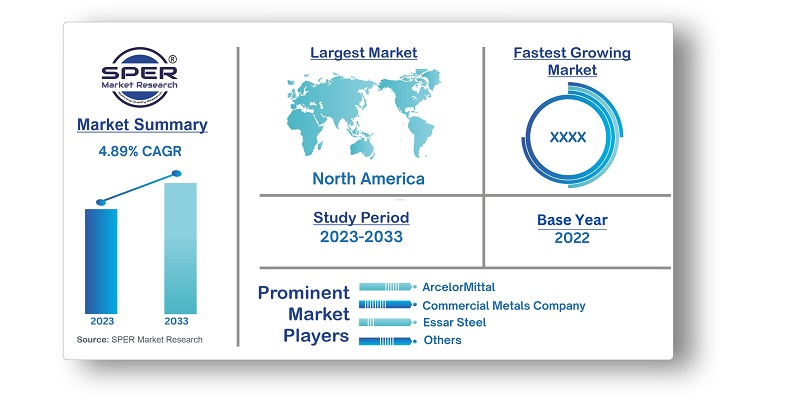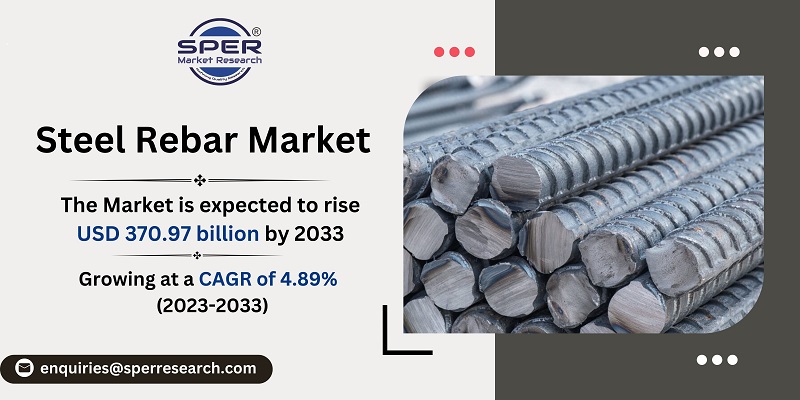
Steel Rebar Market Growth, Trends, Share, Size, Revenue, Scope and Future Opportunities Till 2033
Steel Rebar Market Size- By Type, By Coating Type, By Bar Size Type, By Process Type, By End Use Sector - Regional Outlook, Competitive Strategies and Segment Forecast to 2033
| Published: Feb-2023 | Report ID: CHEM2317 | Pages: 1 - 223 | Formats*: |
| Category : Chemical & Materials | |||
- December 2021: The Nucor Corporation announced the approval of the building of a rebar micro mill with spooling capabilities in the South Atlantic area. The new micro mill's CAPEX expenditure is USD 350 million. It is projected to have a yearly output of 430,000 tonnes.
- Globalization and International Trade: The globalization of trade and increased cross-border investments in infrastructure projects contribute to the growth of the steel rebar market. Infrastructure projects that involve steel rebar often require the import or export of the material, leading to increased market demand.


| Report Metric | Details |
| Market size available for years | 2019-2033 |
| Base year considered | 2022 |
| Forecast period | 2023-2033 |
| Segments covered | By Type, By Coating Type, By Bar Size Type, By Process Type, By End Use Sector |
| Regions covered | Asia-Pacific, Europe, Middle East and Africa, North America, Latin America |
| Companies Covered | ArcelorMittal, Celsa Steel (UK) Ltd., Commercial Metals Company, Contractors Materials Company, Daido Steel Co., Ltd., Essar Steel, Gerdau SA, HYUNDAI STEEL, JFE Steel Corporation, Jiangsu Shagang Group Co., Ltd., KOBE STEEL, LTD., Mechel PAO, Nippon Steel Corporation, NLMK Group, Nucor Corporation, SAIL, Sohar Steel Group, Steel Dynamics, Inc., Tata Steel Limited, Others |
- Construction Companies
- Infrastructure Developers
- Architects and Engineers
- Government Organizations
- Distributors and Suppliers
- Contractors and Subcontractors
- Real Estate Developers
- Industry Associations and Trade Organizations
- Investors and Financial Institutions
- Research and Development Institutions
| By Type: |
|
| By Coating Type: |
|
| By Bar Size Type: |
|
| By Process Type: |
|
| By End Use Sector: |
|
- Global Steel Rebar Market Size (FY’2023-FY’2033)
- Overview of Global Steel Rebar Market
- Segmentation of Global Steel Rebar Market By Type (Deformed, Mild)
- Segmentation of Global Steel Rebar Market By Coating Type (Plain Carbon Steel Rebar, Galvanized Steel Rebar, Epoxy Coated Steel Rebar)
- Segmentation of Global Steel Rebar Market By Bar Size Type (#3 Bar size, #4 Bar size, #5 Bar size, #8 Bar size, Others)
- Segmentation of Global Steel Rebar Market By Process Type (Basic Oxygen Steelmaking, Electric Arc Furnace)
- Segmentation of Global Steel Rebar Market By End Use Sector (Infrastructure, Residential, Industrial)
- Statistical Snap of Global Steel Rebar Market
- Expansion Analysis of Global Steel Rebar Market
- Problems and Obstacles in Global Steel Rebar Market
- Competitive Landscape in the Global Steel Rebar Market
- Impact of COVID-19 and Demonetization on Global Steel Rebar Market
- Details on Current Investment in Global Steel Rebar Market
- Competitive Analysis of Global Steel Rebar Market
- Prominent Players in the Global Steel Rebar Market
- SWOT Analysis of Global Steel Rebar Market
- Global Steel Rebar Market Future Outlook and Projections (FY’2023-FY’2033)
- Recommendations from Analyst
1.1. Scope of the report1.2. Market segment analysis
2.1. Research data source2.1.1. Secondary Data2.1.2. Primary Data2.1.3. SPER’s internal database2.1.4. Premium insight from KOL’s2.2. Market size estimation2.2.1. Top-down and Bottom-up approach2.3. Data triangulation
4.1. Driver, Restraint, Opportunity and Challenges analysis4.1.1. Drivers4.1.2. Restraints4.1.3. Opportunities4.1.4. Challenges4.2. COVID-19 Impacts of the Global Steel Rebar Market
5.1. SWOT Analysis5.1.1. Strengths5.1.2. Weaknesses5.1.3. Opportunities5.1.4. Threats5.2. PESTEL Analysis5.2.1. Political Landscape5.2.2. Economic Landscape5.2.3. Social Landscape5.2.4. Technological Landscape5.2.5. Environmental Landscape5.2.6. Legal Landscape5.3. PORTER’s Five Forces5.3.1. Bargaining power of suppliers5.3.2. Bargaining power of buyers5.3.3. Threat of Substitute5.3.4. Threat of new entrant5.3.5. Competitive rivalry5.4. Heat Map Analysis
6.1. Global Steel Rebar Market Manufacturing Base Distribution, Sales Area, Product Type6.2. Mergers & Acquisitions, Partnerships, Product Launch, and Collaboration in Global Steel Rebar Market
7.1. Global Steel Rebar Market Value Share and Forecast, By Type, 2023-20337.2. Deformed7.3. Mild
8.1. Global Steel Rebar Market Value Share and Forecast, By Coating Type, 2023-20338.2. Plain Carbon Steel Rebar8.3. Galvanized Steel Rebar8.4. Epoxy Coated Steel Rebar
9.1. Global Steel Rebar Market Value Share and Forecast, By Bar Size Type, 2023-20339.2. #3 Bar size9.3. #4 Bar size9.4. #5 Bar size9.5. #8 Bar size9.6. Others
10.1. Global Steel Rebar Market Value Share and Forecast, By Process Type, 2023-203310.2. Basic Oxygen Steelmaking10.3. Electric Arc Furnace
11.1. Global Steel Rebar Market Value Share and Forecast, By End Use Sector, 2023-203311.2. Infrastructure11.3. Residential11.4. Industrial
12.1. Global Steel Rebar Market Size and Market Share
13.1. Global Steel Rebar Market Size and Market Share By Type (2019-2026)13.2. Global Steel Rebar Market Size and Market Share By Type (2027-2033)
14.1. Global Steel Rebar Market Size and Market Share By Coating Type (2019-2026)14.2. Global Steel Rebar Market Size and Market Share By Coating Type (2027-2033)
15.1. Global Steel Rebar Market Size and Market Share By Bar Size Type (2019-2026)15.2. Global Steel Rebar Market Size and Market Share By Bar Size Type (2027-2033)
16.1. Global Steel Rebar Market Size and Market Share By Process Type (2019-2026)16.2. Global Steel Rebar Market Size and Market Share By Process Type (2027-2033)
17.1. Global Steel Rebar Market Size and Market Share By End Use Sector (2019-2026)17.2. Global Steel Rebar Market Size and Market Share By End Use Sector (2027-2033)
18.1. Global Steel Rebar Market Size and Market Share By Region (2019-2026)18.2. Global Steel Rebar Market Size and Market Share By Region (2027-2033)18.3. Asia-Pacific18.3.1. Australia18.3.2. China18.3.3. India18.3.4. Japan18.3.5. South Korea18.3.6. Rest of Asia-Pacific18.4. Europe18.4.1. France18.4.2. Germany18.4.3. Italy18.4.4. Spain18.4.5. United Kingdom18.4.6. Rest of Europe18.5. Middle East and Africa18.5.1. Kingdom of Saudi Arabia18.5.2. United Arab Emirates18.5.3. Rest of Middle East & Africa18.6. North America18.6.1. Canada18.6.2. Mexico18.6.3. United States18.7. Latin America18.7.1. Argentina18.7.2. Brazil18.7.3. Rest of Latin America
19.1. ArcelorMittal19.1.1. Company details19.1.2. Financial outlook19.1.3. Product summary19.1.4. Recent developments19.2. Celsa Steel (UK) Ltd.19.2.1. Company details19.2.2. Financial outlook19.2.3. Product summary19.2.4. Recent developments19.3. Commercial Metals Company19.3.1. Company details19.3.2. Financial outlook19.3.3. Product summary19.3.4. Recent developments19.4. Contractors Materials Company19.4.1. Company details19.4.2. Financial outlook19.4.3. Product summary19.4.4. Recent developments19.5. Daido Steel Co., Ltd.19.5.1. Company details19.5.2. Financial outlook19.5.3. Product summary19.5.4. Recent developments19.6. Essar Steel19.6.1. Company details19.6.2. Financial outlook19.6.3. Product summary19.6.4. Recent developments19.7. Gerdau SA19.7.1. Company details19.7.2. Financial outlook19.7.3. Product summary19.7.4. Recent developments19.8. HYUNDAI STEEL19.8.1. Company details19.8.2. Financial outlook19.8.3. Product summary19.8.4. Recent developments19.9. JFE Steel Corporation19.9.1. Company details19.9.2. Financial outlook19.9.3. Product summary19.9.4. Recent developments19.10. Jiangsu Shagang Group Co., Ltd.19.10.1. Company details19.10.2. Financial outlook19.10.3. Product summary19.10.4. Recent developments19.11. KOBE STEEL, LTD.19.11.1. Company details19.11.2. Financial outlook19.11.3. Product summary19.11.4. Recent developments19.12. Mechel PAO19.12.1. Company details19.12.2. Financial outlook19.12.3. Product summary19.12.4. Recent developments19.13. Nippon Steel Corporation19.13.1. Company details19.13.2. Financial outlook19.13.3. Product summary19.13.4. Recent developments19.14. NLMK Group19.14.1. Company details19.14.2. Financial outlook19.14.3. Product summary19.14.4. Recent developments19.15. Nucor Corporation19.15.1. Company details19.15.2. Financial outlook19.15.3. Product summary19.15.4. Recent developments19.16. SAIL (Steel Authority of India Limited)19.16.1. Company details19.16.2. Financial outlook19.16.3. Product summary19.16.4. Recent developments19.17. Sohar Steel Group19.17.1. Company details19.17.2. Financial outlook19.17.3. Product summary19.17.4. Recent developments19.18. Steel Dynamics, Inc.19.18.1. Company details19.18.2. Financial outlook19.18.3. Product summary19.18.4. Recent developments19.19. Tata Steel Limited19.19.1. Company details19.19.2. Financial outlook19.19.3. Product summary19.19.4. Recent developments19.20. Others
SPER Market Research’s methodology uses great emphasis on primary research to ensure that the market intelligence insights are up to date, reliable and accurate. Primary interviews are done with players involved in each phase of a supply chain to analyze the market forecasting. The secondary research method is used to help you fully understand how the future markets and the spending patterns look likes.
The report is based on in-depth qualitative and quantitative analysis of the Product Market. The quantitative analysis involves the application of various projection and sampling techniques. The qualitative analysis involves primary interviews, surveys, and vendor briefings. The data gathered as a result of these processes are validated through experts opinion. Our research methodology entails an ideal mixture of primary and secondary initiatives.



Frequently Asked Questions About This Report
PLACE AN ORDER
Year End Discount
Sample Report
Pre-Purchase Inquiry
NEED CUSTOMIZATION?
Request CustomizationCALL OR EMAIL US
100% Secure Payment






Related Reports
Our Global Clients
Our data-driven insights have influenced the strategy of 200+ reputed companies across the globe.




















